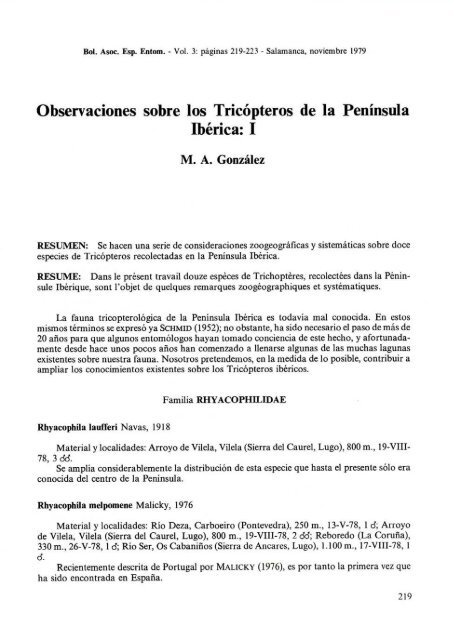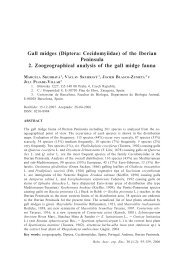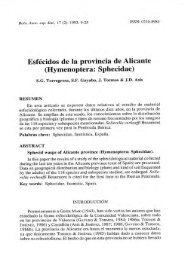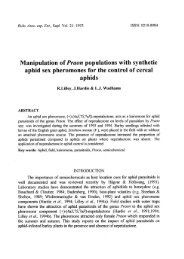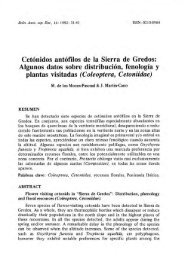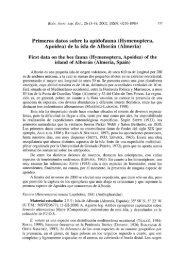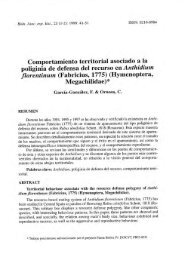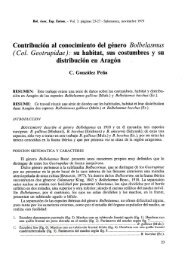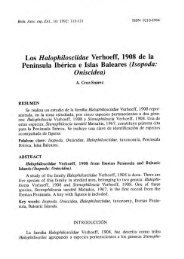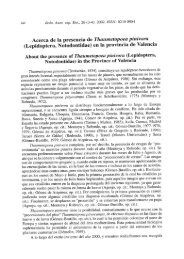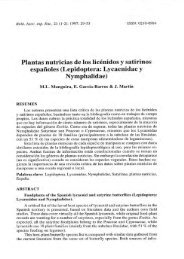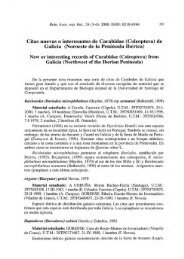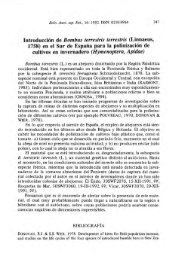Observaciones sobre los Tricópteros de la Península Ibérica: I
Observaciones sobre los Tricópteros de la Península Ibérica: I
Observaciones sobre los Tricópteros de la Península Ibérica: I
You also want an ePaper? Increase the reach of your titles
YUMPU automatically turns print PDFs into web optimized ePapers that Google loves.
Bol. Asoc. Esp. Entom. - Vol. 3: páginas 219-223 - Sa<strong>la</strong>manca, noviembre 1979<br />
<strong>Observaciones</strong> <strong>sobre</strong> <strong>los</strong> <strong>Tricópteros</strong> <strong>de</strong> <strong>la</strong> Penínsu<strong>la</strong><br />
<strong>Ibérica</strong>: I<br />
M. A. González<br />
RESUMEN: Se hacen una serie <strong>de</strong> consi<strong>de</strong>raciones zoogeográficas y sistemáticas <strong>sobre</strong> doce<br />
especies <strong>de</strong> <strong>Tricópteros</strong> recolectadas en <strong>la</strong> Penínsu<strong>la</strong> <strong>Ibérica</strong>.<br />
RESUME: Dans le présent travail douze espéces <strong>de</strong> Trichoptéres, recolectées dans <strong>la</strong> Péninsule<br />
Ibérique, sont l'objet <strong>de</strong> quelques remarques zoogéographiques et systématiques.<br />
La fauna tricopterológica <strong>de</strong> <strong>la</strong> Penínsu<strong>la</strong> <strong>Ibérica</strong> es todavía mal conocida. En estos<br />
mismos términos se expresó ya SCHMID (1952); no obstante, ha sido necesario el paso <strong>de</strong> más <strong>de</strong><br />
20 años para que algunos entomólogos hayan tomado conciencia <strong>de</strong> este hecho, y afortunadamente<br />
<strong>de</strong>s<strong>de</strong> hace unos pocos años han comenzado a llenarse algunas <strong>de</strong> <strong>la</strong>s muchas <strong>la</strong>gunas<br />
existentes <strong>sobre</strong> nuestra fauna. Nosotros preten<strong>de</strong>mos, en <strong>la</strong> medida <strong>de</strong> lo posible, contribuir a<br />
ampliar <strong>los</strong> conocimientos existentes <strong>sobre</strong> <strong>los</strong> <strong>Tricópteros</strong> ibéricos.<br />
Rhyacophi<strong>la</strong> <strong>la</strong>ufferi Navas, 1918<br />
Familia RHYACOPHILIDAE<br />
Material y localida<strong>de</strong>s: Arroyo <strong>de</strong> Vue<strong>la</strong>, Vue<strong>la</strong> (Sierra <strong>de</strong>l Caurel, Lugo), 800 m., 19-VIII-<br />
78, 3 dd.<br />
Se amplía consi<strong>de</strong>rablemente <strong>la</strong> distribución <strong>de</strong> esta especie que hasta el presente sólo era<br />
conocida <strong>de</strong>l centro <strong>de</strong> <strong>la</strong> Penínsu<strong>la</strong>.<br />
Rhyacophi<strong>la</strong> melpomene Malicky, 1976<br />
Material y localida<strong>de</strong>s: Río Deza, Carboeiro (Pontevedra), 250 m., 13-V-78, 1 d; Arroyo<br />
<strong>de</strong> Vue<strong>la</strong>, Vue<strong>la</strong> (Sierra <strong>de</strong>l Caurel, Lugo), 800 m., 19-VIII-78, 2 dd; Reboredo (La Coruña),<br />
330 m., 26-V-78, 1 d; Río Ser, Os Cabaniños (Sierra <strong>de</strong> Aneares, Lugo), 1.100 m., 17-VJII-78, 1<br />
d.<br />
Recientemente <strong>de</strong>scrita <strong>de</strong> Portugal por MALICKY (1976), es por tanto <strong>la</strong> primera vez que<br />
ha sido encontrada en España.<br />
219
Rhyacophüa pulchra Schmid, 1952<br />
Material y localida<strong>de</strong>s: Río Ferreira, Guntín (Lugo), 600 m., 21-IX-77, 1 d (ninfa madura).<br />
Ampliamos <strong>la</strong> distribución <strong>de</strong> esta especie que Juntamente con Rh. <strong>la</strong>ujferi, era so<strong>la</strong>mente<br />
conocida, hasta el momento, <strong>de</strong>l centro <strong>de</strong> <strong>la</strong> Penínsu<strong>la</strong>.<br />
Rhyacophi<strong>la</strong> terpsichore Malicky, 1976<br />
Material y localida<strong>de</strong>s: Río Ferreira, Guntín (Lugo), 600 m., 20-IX-77, 1 cf (ninfa madura).<br />
Al igual que Rh. melpomene, es una especie <strong>de</strong> reciente <strong>de</strong>scripción, conocida hasta el<br />
momento so<strong>la</strong>mente <strong>de</strong> Portugal. Es por tanto <strong>la</strong> primera vez que se cita <strong>de</strong> una localidad<br />
españo<strong>la</strong>.<br />
Familia POLYCENTROPIDAE<br />
Polycentropus intricatus Morton, 1910 ( = P. almanzor Schmid, 1952)<br />
Material y localida<strong>de</strong>s: Rio Ser, Os Cabaniños (Sierra <strong>de</strong> Aneares, Lugo), 1.100 m., 17-<br />
VIII-78, 1 d; Arroyo <strong>de</strong> Vue<strong>la</strong>, Vue<strong>la</strong> (Sierra <strong>de</strong>l Caurel, Lugo), 800 m.; 19-VIII-78, 4 66.<br />
La vali<strong>de</strong>z <strong>de</strong> P. almanzor como especie ha sido recientemente puesta en duda por<br />
BOTOSANEANU y MALICKY (1978). En efecto, el estudio <strong>de</strong> <strong>la</strong>s figuras <strong>de</strong> <strong>los</strong> aparatos genitales<br />
<strong>de</strong> ambas especies (ver MORTON, 1910 y SCHMID, 1952 b), reve<strong>la</strong> <strong>la</strong> imposibilidad <strong>de</strong> encontrar<br />
caracteres válidos para separar<strong>la</strong>s, y, por tanto, <strong>la</strong> elección <strong>de</strong> una u otra es totalmente<br />
arbitraria. Resulta por otra parte bastante significativo el hecho <strong>de</strong> que SCHMID (1952 b, p.<br />
666) al seña<strong>la</strong>r <strong>la</strong> re<strong>la</strong>ción <strong>de</strong> P. almanzor con <strong>la</strong>s <strong>de</strong>más especies <strong>de</strong>l género, se exprese en <strong>los</strong><br />
siguientes términos: «Cette espéce est tres voisine <strong>de</strong>f<strong>la</strong>vosticus Hag. et <strong>de</strong> excisus K<strong>la</strong>p.». En<br />
nuestra opinión, resulta sorpren<strong>de</strong>nte (en el supuesto <strong>de</strong> admitir <strong>la</strong> vali<strong>de</strong>z específica <strong>de</strong> P.<br />
almanzor) no seña<strong>la</strong>r a P. intricatus como especie vecina <strong>de</strong> P. almanzor.<br />
P. intricatus es conocida <strong>de</strong> <strong>los</strong> Pirineos franceses y Centro <strong>de</strong> Francia. En <strong>la</strong> Penínsu<strong>la</strong> ha<br />
sido citada <strong>de</strong> <strong>la</strong> Sierra <strong>de</strong> Credos (bajo el nombre <strong>de</strong> P. almanzor). La captura <strong>de</strong> estos<br />
ejemp<strong>la</strong>res en Galicia constituye, pues, <strong>la</strong> segunda cita <strong>de</strong> esta especie en <strong>la</strong> Penínsu<strong>la</strong>.<br />
Odontocerum albicorne (Scopoli, 1763)<br />
Familia ODONTOCERIDAE<br />
Material y localida<strong>de</strong>s: Arroyo <strong>de</strong> Vile<strong>la</strong>, Vue<strong>la</strong> (Sierra <strong>de</strong>l Caurel, Lugo), 800 m., 19-VIII-<br />
78, 21 oU 4 99; Río Cance<strong>la</strong>da, Vil<strong>la</strong>nueva (Lugo), 750 m., 1S-VIII-78, 4 dtf; Río Ser, Os<br />
Cabaniños (Sierra <strong>de</strong> Aneares, Lugo), 1.100 m., 17-VIII-78, 6 do*; Pacios (Sierra <strong>de</strong>l Caurel,<br />
Lugo), 1.000 m., 20-VIII-78, 1 d<br />
Ha sido citada esta especie <strong>de</strong> diversas localida<strong>de</strong>s <strong>de</strong> <strong>la</strong> Penínsu<strong>la</strong> <strong>Ibérica</strong> (NAVAS, 1908,<br />
etc...; SCHMID, 1952 b), y, por tanto, hasta hace poco tiempo su presencia en nuestro territorio<br />
ha sido comúnmente admitida.<br />
MALICKY (1975) ha <strong>de</strong>scrito <strong>de</strong> Portugal Odontocerum lusitanicum Malicky, 1975, especie<br />
tan sólo diferenciable <strong>de</strong> O. albicorne por su menor tamaño y por tener <strong>los</strong> machos <strong>la</strong>s a<strong>la</strong>s<br />
posteriores más redon<strong>de</strong>adas, careciendo <strong>de</strong> utilidad el estudio <strong>de</strong> <strong>los</strong> aparatos genitales <strong>de</strong><br />
ambas especies para diferenciar<strong>la</strong>s. La gran similitud entre <strong>la</strong>s mismas ha inducido a BOTOSA-<br />
NEANU y MALICKY (1978) a consi<strong>de</strong>rar dudosas <strong>la</strong>s citas <strong>de</strong> O. albicorne antes mencionadas.<br />
220
Gracias a <strong>la</strong> gentileza <strong>de</strong> L. da Terra, hemos podido estudiar ejemp<strong>la</strong>res portugueses <strong>de</strong> O.<br />
lusitanicum, resultando estos duramente diferencíateles, por <strong>los</strong> caracteres antes mencionados<br />
(tamaño y a<strong>la</strong>s posteriores <strong>de</strong> <strong>los</strong> machos), <strong>de</strong> <strong>los</strong> ejemp<strong>la</strong>res capturados por nosotros en<br />
Galicia, que hemos i<strong>de</strong>ntificado como O. albicorne.<br />
Comprobada, pues, <strong>la</strong> presencia <strong>de</strong> albicorne en Galicia, <strong>de</strong>bemos conce<strong>de</strong>r un cierto<br />
margen <strong>de</strong> confianza a <strong>la</strong>s citas que existen <strong>sobre</strong> esta especie <strong>de</strong> otras localida<strong>de</strong>s <strong>de</strong> <strong>la</strong><br />
Penínsu<strong>la</strong>.<br />
Beraea ma<strong>la</strong>tebrera Schmid, 1952<br />
Familia BERAEIDAE<br />
Material y localida<strong>de</strong>s: Río Moreira, Pedraza (Lugo), 520 m., 24-VII-78, 3 dd<br />
Especie so<strong>la</strong>mente conocida, hasta el momento actual, <strong>de</strong> <strong>la</strong> Sierra <strong>de</strong>l Guadarrama.<br />
Brachycentrus subnubilus Curtis, 1834<br />
Familia BRACHYCENTRIDAE<br />
Material y localida<strong>de</strong>s: Río Tambre, Fuentealbar (La Coruña), 200 m., 10-111-79, 12 d
Chaetopteryx vil<strong>los</strong>a (Fabricius, 1798)<br />
Material y localida<strong>de</strong>s: Puente <strong>de</strong>l Vadillo (Madrid), 21-X-75, 6 cid y 4 99.<br />
Aunque en <strong>la</strong> actualidad esta especie no se encuentra seña<strong>la</strong>da en <strong>la</strong> Penínsu<strong>la</strong> <strong>Ibérica</strong> (ver<br />
BOTOSANEANU y MALICKY, 1978), ha sido ya citada, con anterioridad a nuestras capturas, por<br />
NAVAS (1916) <strong>de</strong> Moncayo (Zaragoza). Ratificamos, por tanto, <strong>la</strong> presencia <strong>de</strong> esta especie en<br />
nuestro territorio, por lo que pasan a ser tres <strong>la</strong>s especies <strong>de</strong>l género Chaetopteryx Stephens,<br />
1837, conocidas <strong>de</strong> <strong>la</strong> Penínsu<strong>la</strong> <strong>Ibérica</strong>: Ch. vil<strong>los</strong>a, Ch. atlántica Malicky, 1975 y Ch. lusitanica<br />
Malicky, 1974, siendo <strong>la</strong>s dos últimas endémicas y <strong>de</strong> reciente <strong>de</strong>scripción. Se confirma, por<br />
tanto, <strong>la</strong> antigua suposición <strong>de</strong> SCHMID (1952, p. 106) expresada en <strong>los</strong> siguientes términos:<br />
«Beaucoup <strong>de</strong> Chaetopteryx sont sans doute encoré a découvrir, proteges qu'ils sont par leur<br />
vie automnale et montagnar<strong>de</strong> et par leurs moeurs cachees».<br />
Thremma tel<strong>la</strong>e González, 1978<br />
Familia THREMMATIDAE<br />
Material y localida<strong>de</strong>s: Arroyo <strong>de</strong> Vue<strong>la</strong>, Vile<strong>la</strong> (Sierra <strong>de</strong>l Caurel, Lugo), 800 m., 19-VIII-<br />
78, 2 dd; Río Ferreira, Guntín (Lugo), 600 m., 23-VII-78, 1 d; Río Moreira, Pedraza (Lugo),<br />
520 m., 6-IV-79, 2dd; El Pau<strong>la</strong>r (Sierra <strong>de</strong>l Guadarrama, Madrid), 1.200 m., 15-VII-76, 1 d (V.<br />
Monserrat, leg.); Ribeira <strong>de</strong> Valezim, Valezim (Serra da Estré<strong>la</strong>), Portugal, 720 m., 15-IV-75, 5<br />
dd (L. da Terra, leg.}; Río Alva, Ponte <strong>de</strong> Jugáis, S. Romáo (Serra da Estré<strong>la</strong>), Portugal, 785<br />
m., 15-IV-75, 43 dd (L. da Terra, leg.); Río Gerés (Serra do Gerés), Portugal, 400 m., 7-VIII-74,<br />
6 dd (L. da Terra, leg.).<br />
Recientemente <strong>de</strong>scrita <strong>de</strong> Galicia (GONZÁLEZ, 1978), presumiblemente se encuentre<br />
distribuida por <strong>la</strong> casi totalidad <strong>de</strong> <strong>la</strong> Penínsu<strong>la</strong>, pues hemos podido comprobar <strong>la</strong> existencia <strong>de</strong><br />
esta especie en Portugal (Serra da Estré<strong>la</strong> y Serra do Gerés), así como en el Centro <strong>de</strong> <strong>la</strong><br />
Penínsu<strong>la</strong> (Sierra <strong>de</strong>l Guadarrama). Thremma gallicum McLach<strong>la</strong>n, 1880, también ha sido<br />
capturada por nosotros en Galicia, si bien parece menos abundante que 777. tel<strong>la</strong>e. Es, por<br />
tanto, probable que algunas <strong>de</strong> <strong>la</strong>s citas que hacen referencia a 77?. gallicum correspondan en<br />
realidad a Th. tel<strong>la</strong>e.<br />
AGRADECIMIENTOS<br />
Agra<strong>de</strong>zco a <strong>los</strong> Drs. L. S. Whytton da Terra y V. Monserrat <strong>la</strong> gentileza <strong>de</strong> proporcionarme<br />
material proce<strong>de</strong>nte <strong>de</strong> sus colecciones particu<strong>la</strong>res.<br />
BIBLIOGRAFÍA<br />
BOTOSANEANU, L. and MALICKY, H., 1978. Trichoptera. In: Illies (Ed.), Limnofauna Europaea, 2nd Ed.,<br />
pp: 333-359. Fischer; Stuttgart/New York, Swets and Zeitlinger: Amsterdam.<br />
FILBA, E. L., 1974. Contribución al conocimiento <strong>de</strong> <strong>los</strong> <strong>Tricópteros</strong> caverníco<strong>la</strong>s <strong>de</strong> Cataluña. IV<br />
Simposiun regional Biospeleología. Barcelona, pp.: 21-35.<br />
GONZÁLEZ, M. A., 1978. Descripción <strong>de</strong> Thremma tel<strong>la</strong>e nov. sp. (Trich. Thremmatidae ) <strong>de</strong> <strong>la</strong> Penínsu<strong>la</strong><br />
<strong>Ibérica</strong>. Bol. Asoc. esp, Entom., 2: 201-203.<br />
MALICKY, H., 1975. Fuenfzehn neue mediterrane Kócherfliegen. Mitt. Ent. Ges. Basel, N. F., 25 (3): 81-96.<br />
MALICKY, H., 1976. Beschreibung von 22 neuen westpaláarktischen Kócherfliegen (Trichoptera). Z.<br />
Arbgem. óst. Ent. 27 (3/4): 89-104.<br />
MORTON, K. J., 1910. A new species of Polycentropus (Trichoptera). Entomologist, 43: 3-4.<br />
NAVAS, L., 1908. Neurópteros <strong>de</strong> España y Portugal. Broteria, Ser. Zoo!., 7: 5-131.<br />
NAVAS, L., 1916. Comunicaciones entomológicas. <strong>Tricópteros</strong> <strong>de</strong> Aragón. Rev. Ac. Ci. Zaragoza, 1: 73-85.<br />
222
SCHMID, F., 1952. Le groupe <strong>de</strong> Chaetopieryx (Limnophilidae, Trichoptera). Rev. Suisse Zool., 59: 99-171.<br />
SCHMID, F., 1952 b. Contribution á l'étu<strong>de</strong> <strong>de</strong>s Trichoptéres d'Espagne. Pirineos, 26: 627-695.<br />
SCHMID, F., 1957. Les genres Stenophy<strong>la</strong>x Kol., Micropterna St. et Mesophy<strong>la</strong>x McL. (Trichopt. Limnoph.).<br />
Trab. Mus. Zool. Barcelona, N. S., Zoo!., 2 (2): 1-51.<br />
Fecha <strong>de</strong> recepción: 23 <strong>de</strong> mayo <strong>de</strong> 1979 Marcos Andrés González<br />
Departamento <strong>de</strong> Zoología<br />
Facultad <strong>de</strong> Biología<br />
Universidad <strong>de</strong> Santiago<br />
Santiago <strong>de</strong> Com pos te<strong>la</strong><br />
223


